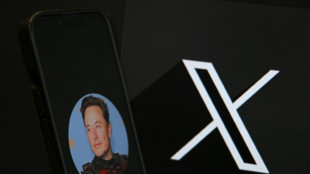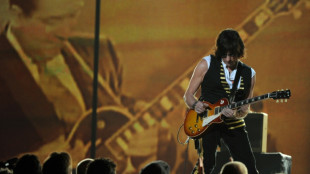
-
 Israel hits Gaza and Lebanon in deadly strikes
Israel hits Gaza and Lebanon in deadly strikes
-
Power cuts as Russian missiles pound Ukraine's energy grid

-
 Denmark's Victoria Kjaer Theilvig crowned Miss Universe 2024
Denmark's Victoria Kjaer Theilvig crowned Miss Universe 2024
-
Dutch police use hologram to try and decode sex worker's murder

-
 Israel bombs south Beirut after Hezbollah targets Haifa area
Israel bombs south Beirut after Hezbollah targets Haifa area
-
Biden in historic Amazon trip as Trump return sparks climate fears

-
 India hails 'historic' hypersonic missile test flight
India hails 'historic' hypersonic missile test flight
-
Israel orders Beirut residents to flee after Hezbollah targets Haifa area

-
 Davis, LeBron power Lakers over Pelicans as Celtics win in OT
Davis, LeBron power Lakers over Pelicans as Celtics win in OT
-
Trump and allies return to New York for UFC fights

-
 Hong Kong political freedoms in spotlight during bumper trial week
Hong Kong political freedoms in spotlight during bumper trial week
-
Debt-saddled Laos struggles to tame rampant inflation

-
 Senna, Schumacher... Beganovic? Macau GP showcases future F1 stars
Senna, Schumacher... Beganovic? Macau GP showcases future F1 stars
-
India's vinyl revival finds its groove

-
 G20 tests Brazil's clout in Lula 3.0 era
G20 tests Brazil's clout in Lula 3.0 era
-
Over 20,000 displaced by gang violence in Haiti: UN agency

-
 Famed gymastics coach Bela Karolyi dies
Famed gymastics coach Bela Karolyi dies
-
'Break taboos': Josep Borrell wraps up time as EU's top diplomat

-
 Climate finance can be hard sell, says aide to banks and PMs
Climate finance can be hard sell, says aide to banks and PMs
-
Trump revives 'peace through strength,' but meaning up to debate

-
 New York auction records expected for a Magritte... and a banana
New York auction records expected for a Magritte... and a banana
-
Egypt's middle class cuts costs as IMF-backed reforms take hold

-
 Beirut businesses struggle to stay afloat under Israeli raids
Beirut businesses struggle to stay afloat under Israeli raids
-
Dupont lauds France 'pragmatism' in tight New Zealand win

-
 Swiatek leads Poland into maiden BJK Cup semi-final
Swiatek leads Poland into maiden BJK Cup semi-final
-
Trump taps fracking magnate and climate skeptic as energy chief

-
 West Indies restore pride with high-scoring win over England
West Indies restore pride with high-scoring win over England
-
Hull clings to one-shot lead over Korda, Zhang at LPGA Annika

-
 Xi tells Biden ready for 'smooth transition' to Trump
Xi tells Biden ready for 'smooth transition' to Trump
-
Trump nominates fracking magnate and climate skeptic as energy secretary

-
 Tyson says 'no regrets' over loss for fighting 'one last time'
Tyson says 'no regrets' over loss for fighting 'one last time'
-
Springboks' Erasmus hails 'special' Kolbe after England try double

-
 France edge out New Zealand in Test thriller
France edge out New Zealand in Test thriller
-
Xi tells Biden will seek 'smooth transition' in US-China ties

-
 Netherlands into Nations League quarter-finals as Germany hit seven
Netherlands into Nations League quarter-finals as Germany hit seven
-
Venezuela to free 225 detained in post-election unrest: source

-
 Late Guirassy goal boosts Guinea in AFCON qualifying
Late Guirassy goal boosts Guinea in AFCON qualifying
-
Biden arrives for final talks with Xi as Trump return looms

-
 Dominant Sinner cruises into ATP Finals title decider with Fritz
Dominant Sinner cruises into ATP Finals title decider with Fritz
-
Dinosaur skeleton fetches 6 million euros in Paris sale

-
 Netherlands-Hungary Nations League match interrupted by medical emergency
Netherlands-Hungary Nations League match interrupted by medical emergency
-
Kolbe double as South Africa condemn England to fifth successive defeat

-
 Kolbe at the double as South Africa condemn England to fresh defeat
Kolbe at the double as South Africa condemn England to fresh defeat
-
Kolbe at the double as South Africa beat England 29-20

-
 'If I don't feel ready, I won't play singles,' says Nadal ahead of Davis Cup farewell
'If I don't feel ready, I won't play singles,' says Nadal ahead of Davis Cup farewell
-
Fifth of dengue cases due to climate change: researchers

-
 Trump's Republican allies tread lightly on Paris pact at COP29
Trump's Republican allies tread lightly on Paris pact at COP29
-
Graham equals record as nine-try Scotland see off tenacious Portugal

-
 Protesters hold pro-Palestinian march in Rio ahead of G20
Protesters hold pro-Palestinian march in Rio ahead of G20
-
Graham equals record as nine-try Scotland see off dogged Portugal


Crown Jewels: The royal family's precious gems
The Crown Jewels form the centrepiece of the royal coronation, and symbolise the pomp and history of the British monarchy over the centuries.
- The Imperial State Crown -
The crown was commissioned for king George VI's coronation in 1937.
Used for formal events such as the state opening of parliament, Queen Elizabeth II wore it following her coronation ceremony.
The crown bears 2,868 diamonds, 269 pearls, 17 sapphires and 11 emeralds.
It weighs 1,060 grams (2.3 pounds) and is 31.5 centimetres (12.4 inches) tall.
The second-largest stone cut from the Cullinan Diamond -- the largest diamond ever mined -- adorns the front.
- The Sovereign's Sceptre -
A gold rod with a globe, cross and dove at the top, the sceptre's design symbolises the Christian Holy Ghost.
It is associated with the monarch's pastoral role towards the people.
It weighs 1,150 grams and is 110.2 centimetres long.
- The Sovereign's Sceptre -
The sceptre represents the monarch's temporal power and good governance and complements the spiritual power symbolised by the Sovereign's Sceptre with Cross.
It weighs 1,170 grams and is 92.2 centimetres long.
The largest colourless cut diamond in the world, the Cullinan I, reigns at the top. It weighs 106 grams and is known as the "First Star of Africa".
The diamond's weight meant the sceptre had to be reinforced in 1910.
- The Sovereign's Orb -
The orb represents the monarch's power and the Christian world.
The gold piece of jewellery is surrounded by a band of diamonds, emeralds, rubies, sapphire and pearls and topped with amethyst and a cross.
It is 27.5 centimetres high and weighs 1,320 grams.
- The gold Ampulla -
The eagle-shaped vessel holds the consecrated oil used in coronation ceremonies.
The eagle's head comes off to allow oil to be poured into the vessel.
The design is based on a legend that the Virgin Mary appeared to medieval English saint Thomas Becket and handed him a golden eagle and oil to anoint future English kings.
It weighs 660 grams and measures 20.7 x 10.4 centimetres.
- The Spurs -
Gold, leather, velvet and gold thread make up one of the most ancient parts of Britain's royal coronation paraphernalia.
The use of spurs to represent knighthood in coronations dates back to the coronation of Richard I in 1189.
Spurs were traditionally fastened to the king's feet during coronation ceremonies but presented and placed on the altar for queens.
- The Cullinan Diamond -
It was the largest diamond ever mined when discovered in South Africa in 1905, weighing 621 grams in its uncut state.
The Transvaal government presented it to King Edward VII on his 66th birthday in 1907 as a gesture of reconciliation after the Second Boer War (1899-1902).
Three employees of Asschers of Amsterdam worked 14-hour days for eight months to cut and polish nine large stones from the original gem.
When workers began to cut the diamond, the first blow broke the knife rather than the diamond.
- St Edward's Crown -
Crown jeweller Robert Viner made it in 1661 for the coronation of king Charles II, after the previous medieval crown was melted down by parliamentarian rebels in 1649 during the English Civil War.
Monarchs did not wear the solid gold crown in coronation ceremonies for more than 200 years as it was too heavy.
It weighs 2,040 grams and is 30.2 centimetres tall.
- Coronation ring -
The ring dates back to the coronation of King William IV in 1831.
Queen Victoria did not wear it for her coronation in 1838 as her fingers were too small.
- Purple Robe of Estate -
Twelve seamstresses from the Royal School of Needlework took 3,500 hours to make it.
The robe is made of silk and embroidered with the monarch's cipher, wheat ears and olive branches.
- The Stone of Scone -
Also known as the "Stone of Destiny", it is the ancient symbol of Scotland's monarchy.
The sandstone slab weighs 152 kilograms (335.1 pounds).
English king Edward I seized it in 1296 and incorporated it into the throne at Westminster, London.
Scottish nationalists stole it from London's Westminster Abbey in 1950 and it later reappeared in Arbroath Abbey, Scotland. It was formally returned to Scotland in 1996.
The stone will only leave Scotland again for a coronation at Westminster Abbey.
A.Moore--AT


